
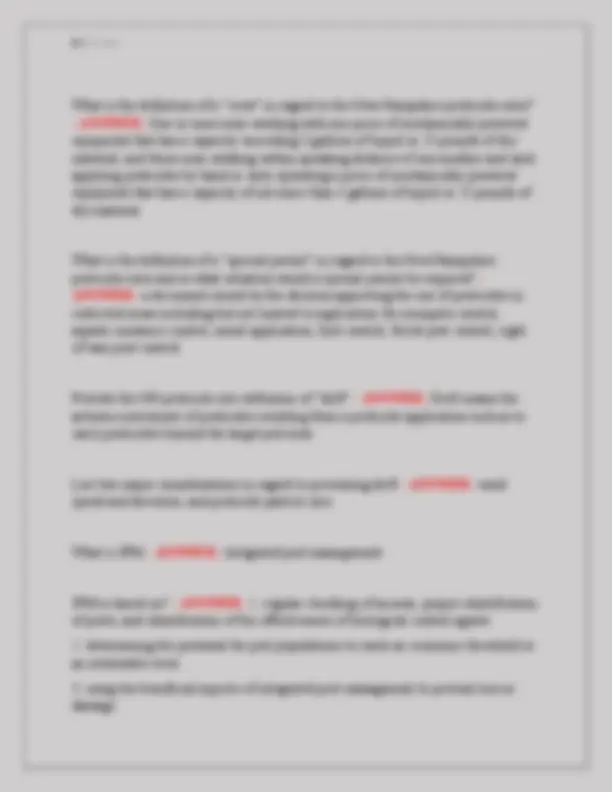
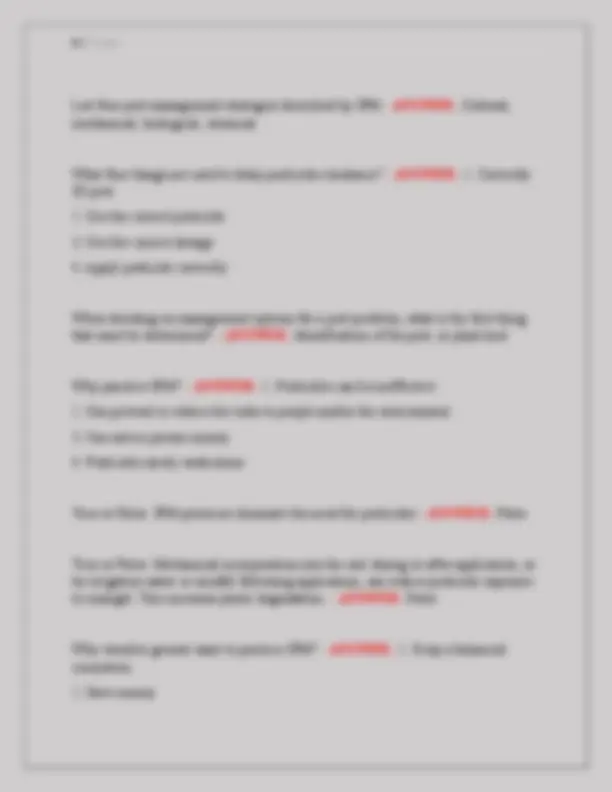
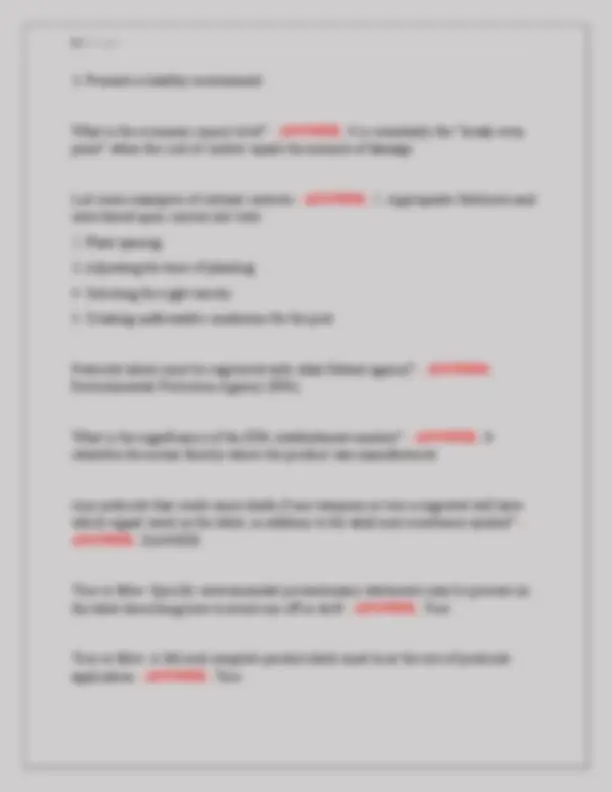
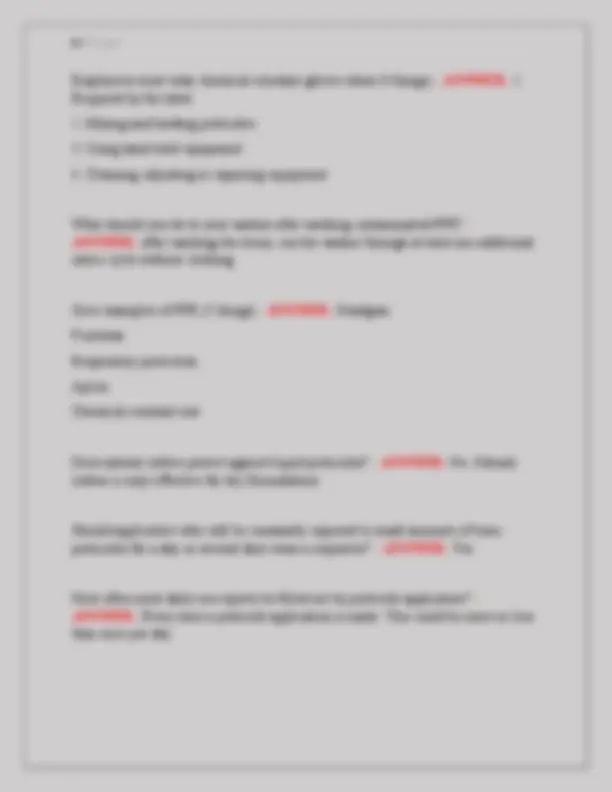
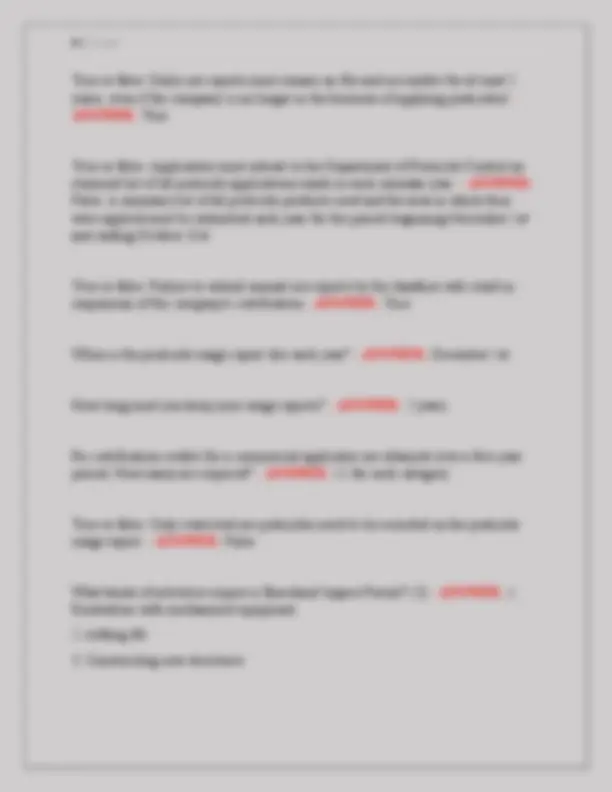
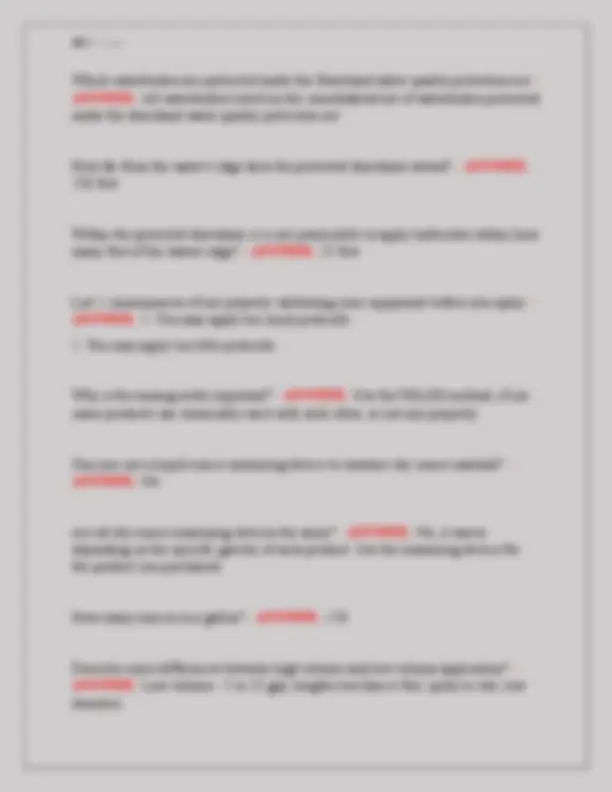
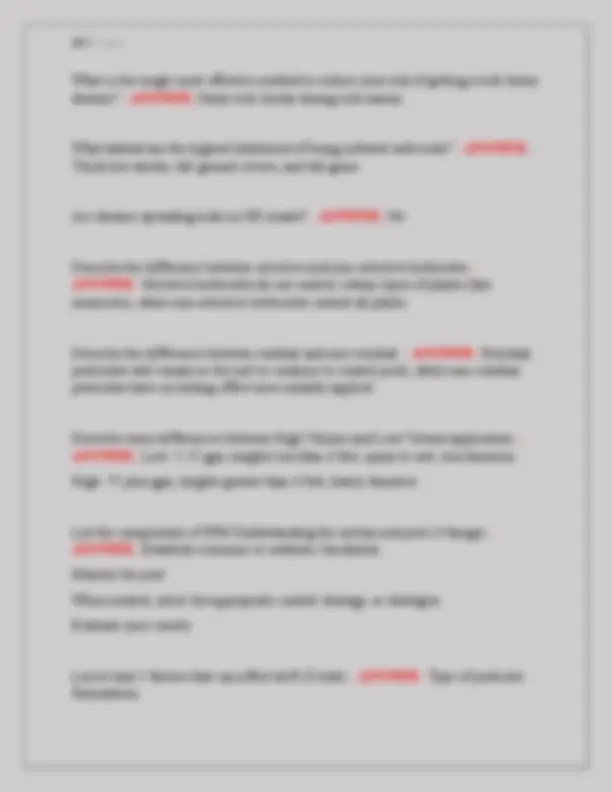
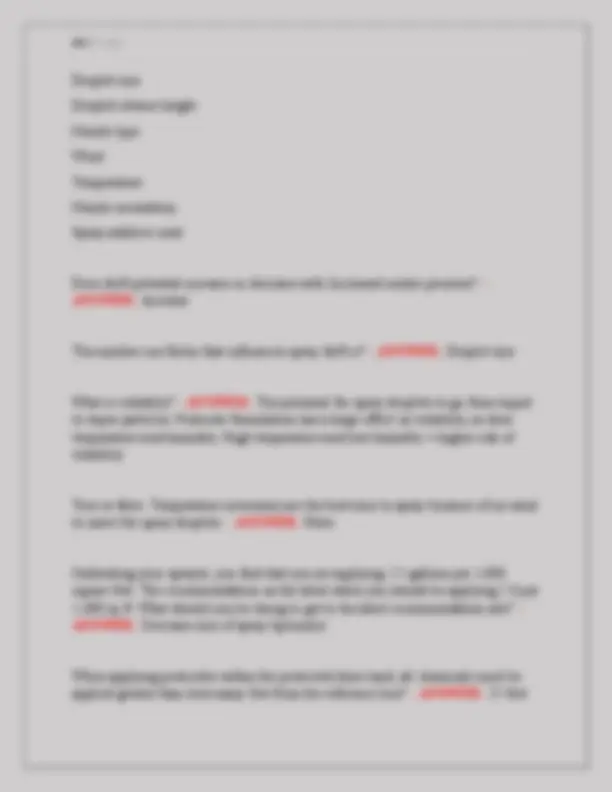
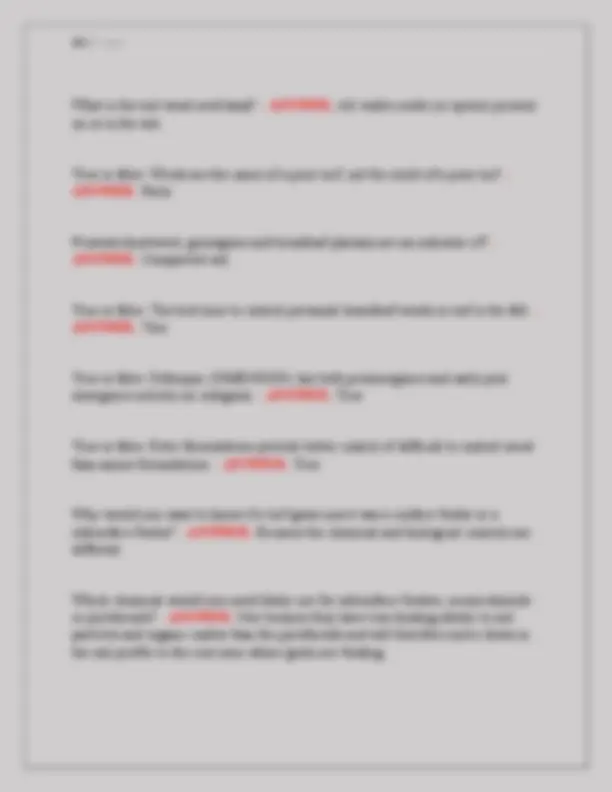
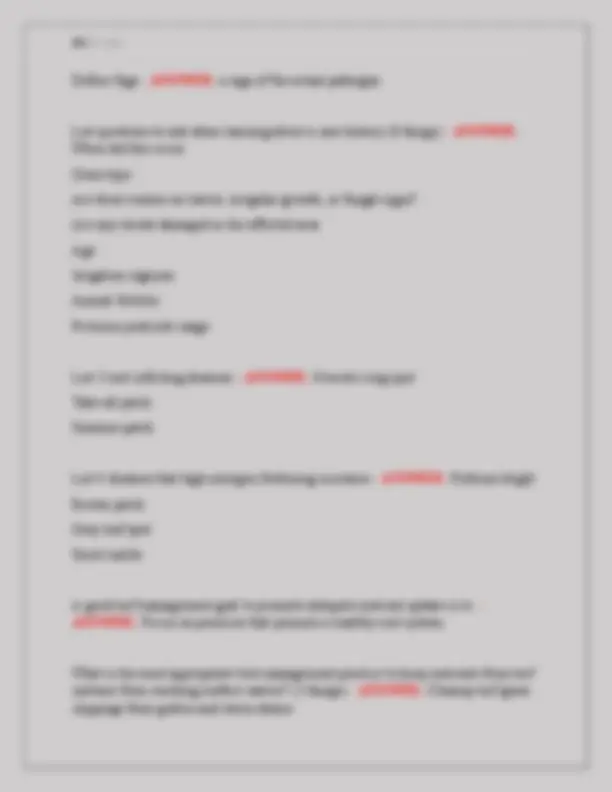
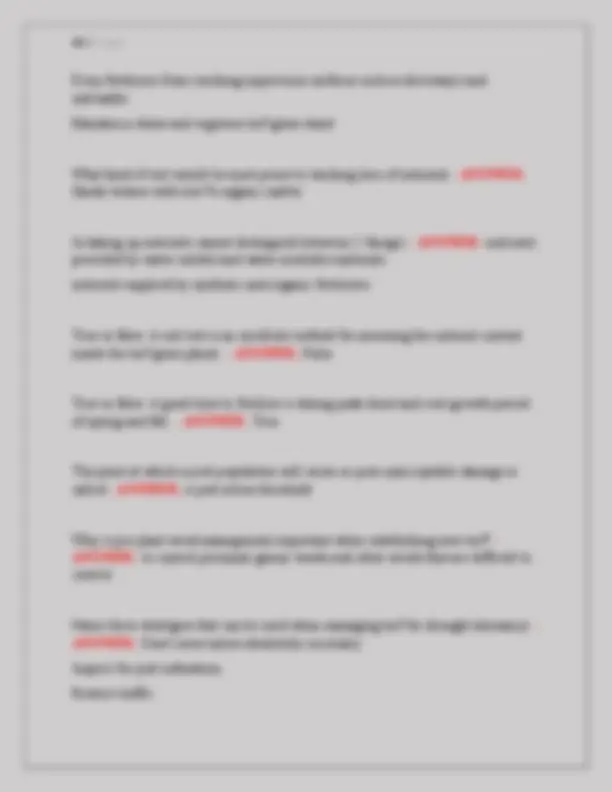
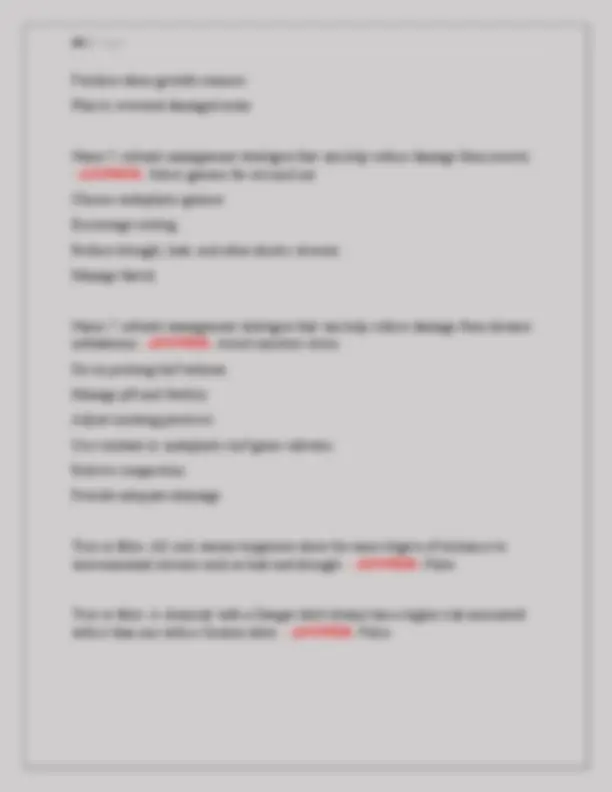
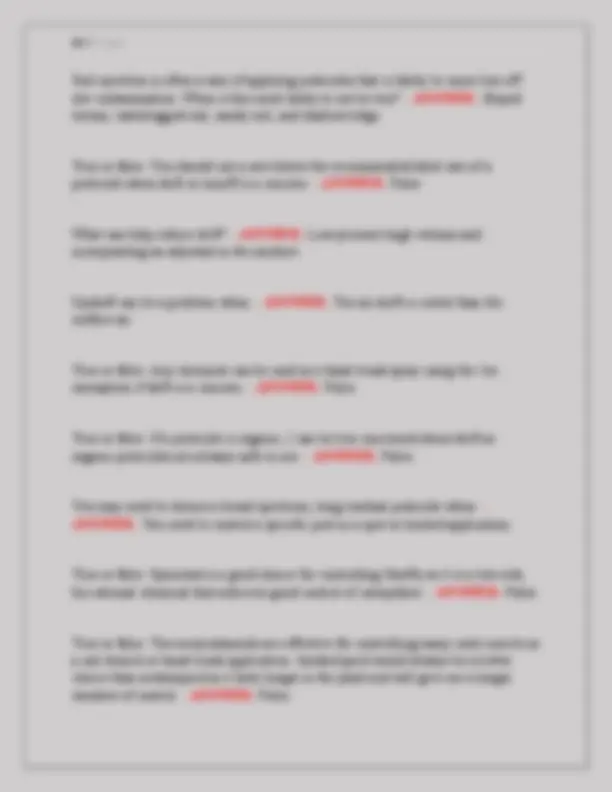
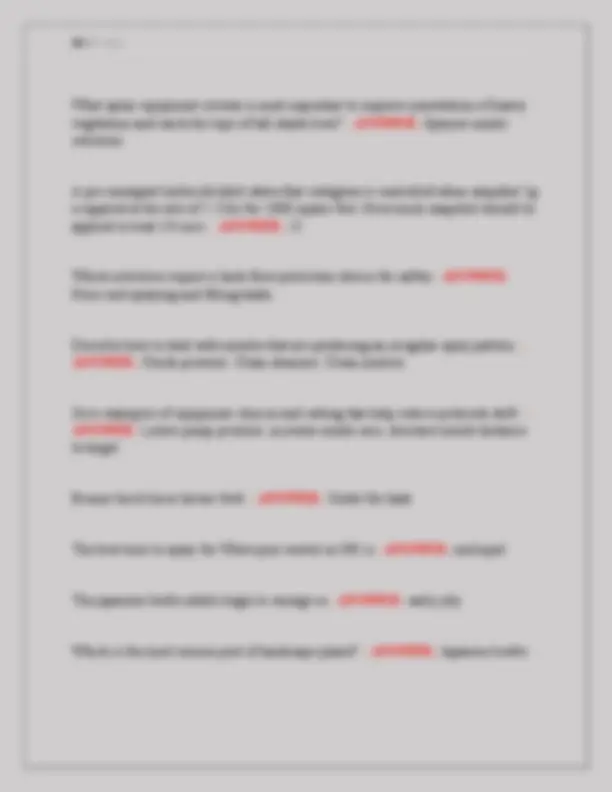
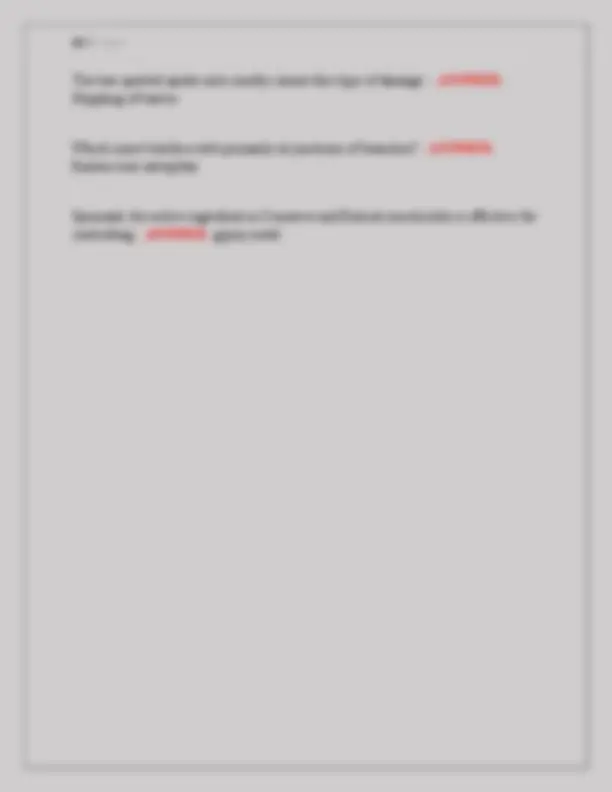


Study with the several resources on Docsity

Earn points by helping other students or get them with a premium plan


Prepare for your exams
Study with the several resources on Docsity

Earn points to download
Earn points by helping other students or get them with a premium plan
Community
Ask the community for help and clear up your study doubts
Discover the best universities in your country according to Docsity users
Free resources
Download our free guides on studying techniques, anxiety management strategies, and thesis advice from Docsity tutors
This study guide provides a comprehensive overview of pesticide regulations and practices in new hampshire. It covers key topics such as setback distances, pesticide classes, licensing requirements, integrated pest management (ipm), pesticide labels, mixing and loading procedures, personal protective equipment (ppe), and reporting requirements. The guide includes numerous questions and answers, making it a valuable resource for individuals seeking to understand and comply with new hampshire's pesticide regulations.
Typology: Exams
1 / 23

This page cannot be seen from the preview
Don't miss anything!
















Where can you find the pesticide setback distances from wells and surface waters?
- ANSWER: http://www.agriculture.nh.gov/publications- forms/documents/setback-brochure.pdf Applying setback: Gravel Packed Public Well - ANSWER: 400 feet Applying setback: Non Gravel Packed Public Well - ANSWER: 250 feet Applying setback: Public Water Supply Within Watershed out to 5 miles - ANSWER: 250 feet Applying setback: Public Waters - ANSWER: 50 feet Applying setback: Non Public Waters - ANSWER: 25 feet Mixing and Loading setback: Gravel Packed Public Well - ANSWER: 400 feet Mixing and Loading setback: Non Gravel Packed Public Well - ANSWER: 250 feet Mixing and Loading setback: All surface water - ANSWER: 75 feet
Mixing and Loading setback: All private water wells - ANSWER: 75 feet Storage/dispensing setback: All public wells - ANSWER: 400 feet Storage/dispensing setback: All private wells - ANSWER: 75 feet Storage/dispensing setback: Surface water - ANSWER: 75 feet Storage/dispensing setback: Public surface water supplies - ANSWER: 400 feet Name the four classes of pesticides identified by New Hampshire regulations and identify the class that cannot be used in New Hampshire - ANSWER: 1. General Use
List four pest management strategies described by IPM - ANSWER: Cultural, mechanical, biological, chemical What four things are used to delay pesticide resistance? - ANSWER: 1. Correctly ID pest
E in WALES - ANSWER: Emulsifiable concentrates S in WALES - ANSWER: Surfactants Why are anti-siphoning devices important to protect the environment? - ANSWER: help keep spray mixture in the tank from escaping down the hose into the water source, stream, pond, or well True or false: If mixing non-liquid pesticides, the containment surface may consist of a tarp made of nonabsorbent materials of adequate thickness to withstand all foreseeable loading conditions - ANSWER: True Why is mixing the time when the applicator is most likely to be dangerously exposed to possible pesticide poisoning? - ANSWER: The applicator is handling the concentrated form of the pesticide. When mixing them, you are more likely to be exposed to liquid splashing on clothing and skin How many times should you rinse an empty pesticide container and measure cups?
- ANSWER: 3 What is PPE? - ANSWER: Personal protective equipment What type of gloves should be worn when handling highly toxic pesticides? - ANSWER: unlined neoprene gloves True or false: The type of PPE needed depends both on the toxicity of the pesticide being used and formulation - ANSWER: True
Employees must wear chemical-resistant gloves when (4 things) - ANSWER: 1. Required by the label
Which waterbodies are protected under the Shoreland water quality protection act - ANSWER: All waterbodies listed on the consolidated list of waterbodies protected under the shoreland water quality protection act How far from the water's edge does the protected shoreland extend? - ANSWER: 250 feet Within the protected shoreland, it is not permissible to apply herbicides within how many feet of the waters edge? - ANSWER: 25 feet List 2 consequences of not properly calibrating your equipment before you spray - ANSWER: 1. You may apply too much pesticide
High volume - 75 plus gpa, heights greater than 6 feet, heavy densities Name four distinct right of way sites - ANSWER: Railroad lines Electric utility lines Pipelines Bicycle, horse, or other paths that are used for public recreation List four goals of vegetation management along the right of way - ANSWER: Maintaining or improving sight visibility Preventing or reducing the spread of noxious weeds Reduce potential fire hazard Maintaining or improving the overall aesthetics of the site List three things to consider when planning a herbicide application to the ROW - ANSWER: Consider the adjacent land Be aware of tree roots that might be in treatment area Water adjacent to the treatment area or in the treatment area True or false: The herbicide label is a legal document and is your best source of information about the product and where it should or should not be used - ANSWER: True List four types of herbicides - ANSWER: Contact Selective Non-selective Pre-emergence
What is the single most effective method to reduce your risk of getting a tick-borne disease? - ANSWER: Daily tick checks during tick season What habitat has the highest likelihood of being infested with ticks? - ANSWER: Thick low shrubs, tall ground covers, and tall grass Are disease spreading ticks in NH ornate? - ANSWER: No Describe the difference between selective and non-selective herbicides - ANSWER: Selective herbicides do not control certain types of plants (like monocots), while non-selective herbicides control all plants. Describe the difference between residual and non-residual. - ANSWER: Residual pesticides will remain in the soil to continue to control pests, while non-residual pesticides have no lasting effect once initially applied. Describe some differences between High Volume and Low Volume application. - ANSWER: Low: 5-25 gpa, heights less than 6 feet, spray to wet, low densities High: 75 plus gpa, heights greater than 6 feet, heavy densities List the components of IPM Understanding the system and pest (4 things) - ANSWER: Establish economic or aesthetic thresholds Monitor the pest When needed, select the appropriate control strategy, or strategies Evaluate your results List at least 5 factors that can affect drift (8 total) - ANSWER: Type of pesticide formulation
Droplet size Droplet release height Nozzle type Wind Temperature Nozzle orientation Spray additive used Does drift potential increase or decrease with Increased nozzle pressure? - ANSWER: Increase The number one factor that influences spray drift is? - ANSWER: Droplet size What is volatility? - ANSWER: The potential for spray droplets to go from liquid to vapor particles. Pesticide formulation has a large effect on volatility, as does temperature and humidity. High temperature and low humidity = higher risk of volatility True or false: Temperature inversions are the best time to spray because of no wind to move the spray droplets. - ANSWER: False Calibrating your sprayer, you find that you are applying 2.5 gallons per 1, square feet. The recommendation on the label states you should be applying 2.0 per 1,000 sq ft. What should you be doing to get to the label recommendation rate? - ANSWER: Decrease size of spray tip/nozzle When applying pesticides within the protected shore land, all chemicals must be applied greater than how many feet from the reference line? - ANSWER: 25 feet
Most of the white grubs we have as pest of turf grasses are introduced species. Why are introduced pests generally more damaging than native insects? - ANSWER: Because introduced pest species do not have the complement of parasites and predators that keep the insect population in check in its native range. How would you identify a grub to species? - ANSWER: By looking at the raster pattern with a 10x or 20x hand lens. List all of the factors that may result in the failures of white grub control. (4 things)
- ANSWER: Lack of sufficient post-treatment irrigation Over-irrigation Too much thatch Runoff of chemical applications on sloped turf grass areas What are some of the things you can do to prevent harming bees? - ANSWER: Do not spray any flowering plants. If the turf to be treated has clover, mow before applying any insecticide (especially sprays). Use the least-toxic chemicals to bees. Which systemic insecticide is considered to have the lowest toxicity to bees? - ANSWER: Acelepryn. Explain the difference between curative and preventative turf grass insect control. - ANSWER: Curative control is making an application when turf grass insects reach a threshold population level. Preventative applications are generally made before the target insect is present but may be based on a history of infestation True or false: There are kentucky bluegrass cultivars that are resistant to billbug feeding. - ANSWER: True
What are the three components of the disease triangle? - ANSWER: Favorable environment Virulent pathogen Susceptible host List as many sources of abiotic injury to turf grass as possible (17 things) - ANSWER: Summer dormancy Fertility Fertilizer burn Too little or too much watering Traffic (compaction) Mower injury Lack of sunlight Excessive thatch Poor drainage Competition Radiant heat from sidewalk Herbicide injury Buried objects Dog injury Gas leak Objects left on grass Bug spray Define Symptom - ANSWER: Alterations of turf grass as a result of disease
Keep fertilizers from reaching impervious surfaces such as driveways and sidewalks Maintain a dense and vigorous turf grass stand What kind of soil would be most prone to leaching loss of nutrients - ANSWER: Sandy texture with low % organic matter In taking up nutrients cannot distinguish between (2 things) - ANSWER: nutrients provided by water soluble and water insoluble materials nutrients supplied by synthetic and organic fertilizers True or false: A soil test is an excellent method for assessing the nutrient content inside the turf grass plants. - ANSWER: False True or false: A good time to fertilize is during peak shoot and root growth period of spring and fall. - ANSWER: True. The point at which a pest population will cause or pose unacceptable damage is called - ANSWER: a pest action threshold Why is pre plant weed management important when establishing new turf? - ANSWER: to control perennial grassy weeds and other weeds that are difficult to control Name three strategies that can be used when managing turf for drought dormancy - ANSWER: Don't mow unless absolutely necessary Inspect for pest infestation Restrict traffic
Fertilize when growth resumes Plan to overseed damaged areas Name 5 cultural management strategies that can help reduce damage from insects.
- ANSWER: Select grasses for site and use Choose endophytic grasses Encourage rooting Reduce drought, heat, and other abiotic stresses Manage thatch Name 7 cultural management strategies that can help reduce damage from disease infestations - ANSWER: Avoid moisture stress Do no prolong leaf wetness Manage pH and fertility Adjust mowing practices Use resistant or endophytic turf grass cultivars Relieve compaction Provide adequate drainage True or false: All cool season turgrasses show the same degree of tolerance to environmental stresses such as heat and drought. - ANSWER: False True or false: A chemical with a Danger label always has a higher risk associated with it than one with a Caution label. - ANSWER: False